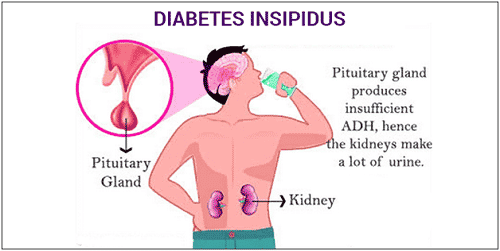What is central (neurogenic) diabetes insipidus?
Central diabetes insipidus (CDI) is different from diabetes, and is significantly more complicated. It name is a deceptive misnomer, as it is completely unrelated to issues with insulin production and blood sugar regulation. While both diseases may cause similar symptoms, treatments and medications for the 2 illnesses are inherently different.
Central diabetes insipidus is also called neurogenic diabetes insipidus. This illness is caused when the body cannot create enough of the hormone vasopressin, which controls how much urine the kidneys produce. Vasopressin increases blood volume and decreases urine volume, which is why its absence causes excessive urination.
In the absence of vasopressin, the kidneys cannot work properly. Therefore, the body rapidly loses a great deal of water, resulting in diluted urine. This causes individuals to become dehydrated, forcing them to drink excess amounts of water.
Anyone may be affected by CDI. This being said, it is a rare condition, with only 1 in every 25,000 individuals suffering from it.
Central diabetes insipidus symptoms
Individuals with central diabetes insipidus typically have the following symptoms:
- Frequent urination (more than 3 liters of urine per day);
- Awakening frequently at night to urinate;
- Bed-wetting;
- Colorless, pale urine;
- Low estimated volume of urine;
- And extreme thirst, leading to the consumption of more than 1 gallon of liquid per day.
In extreme cases, central diabetes insipidus can lead to dehydration, confusion, and loss of consciousness. Symptoms of CDI in children include irritability, low energy, delayed growth, weight loss, fever, and vomiting.
Causes
Central diabetes insipidus can be caused by genetics. Other disorders that can lead to CDI include damage to the pituitary gland or hypothalamus, aneurysm, brain injury, tumors, sarcoidosis or tuberculosis, some forms of encephalitis or meningitis, and a rare disease called Langerhans cell histiocytosis.
Treatment
In mild central diabetes insipidus, the treatment is simply to drink more water. For more severe cases, physicians may prescribe desmopressin, which is a sort of vasopressin. Desmopressin regulates urine output, maintains proper fluid balance, and prevents dehydration. It is generally taken several times per day, and it is available as a nasal spray, tablet, or injection.
Patients should always carry their medications with them and avoid situations where they have no access to water. Additionally, it is advisable for patients to wear “medic alert” jewelry or to keep a note with them to inform medical professionals about their condition in the event of an emergency.
Disclaimer: Please note that the contents of this community article are strictly for informational purposes and should not be considered as medical advice. This article, and other community articles, are not written or reviewed for medical validity by Canadian Insulin or its staff. All views and opinions expressed by the contributing authors are not endorsed by Canadian Insulin. Always consult a medical professional for medical advice, diagnosis, and treatment.


